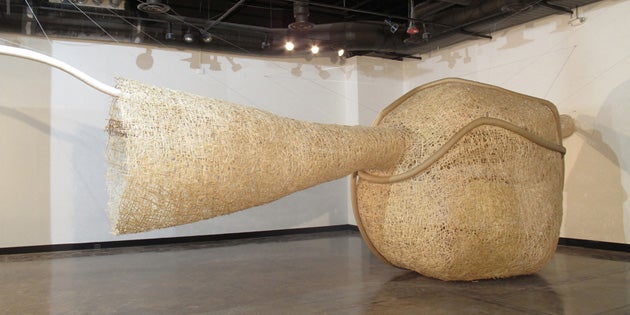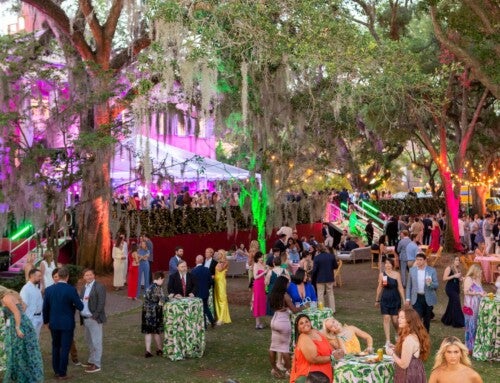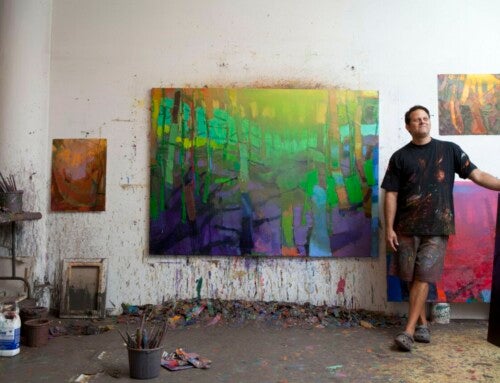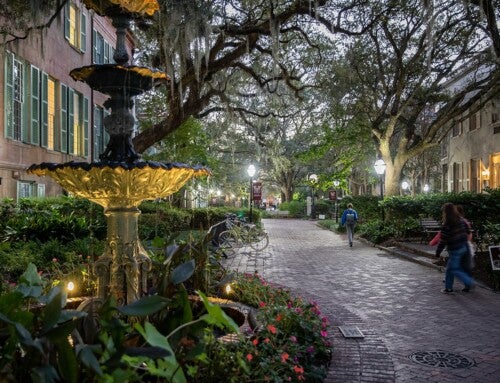When Jonathan Brilliant ’02 entered graduate school at San Jose State University, he began a life phase he describes as “very reductive.”
The M.F.A. candidate soon forfeited a studio, deliberately limited the use of color in his art and shaved his head. He rejected many tools and technology, opting to read more books. Meanwhile, Brilliant was attracted to British natural artists such as Andy Goldsworthy, who began creating art in the 1970s through the arrangement of found objects in a landscape, such as stones, leaves and sticks.
Putting his own twist on this method, Brilliant chose a decidedly less natural, but perhaps more relevant, modern-day landscape from which to gather materials: the local coffee shop. Brilliant scoured coffee shops within a two-mile radius to collect as many cardboard sleeves, plastic lids and wooden coffee stirrers as he could. Then, he began creating.
He had no idea this was the beginning of an artistic method that would come to substantially define him as an artist. But, 10 years after first working with coffee shop supplies, Brilliant continues to work with these discardable items, creating massive installations across the country and world. These days, however, he buys the supplies himself – and in bulk.
Brilliant’s most eye-catching works are the large, room-filling sculptures he makes almost entirely from woven wooden coffee stirrers.
“It’s my way of making a big drawing,” he says.
Most people are amazed to learn that Brilliant’s sculptures contain no glue and remain in place from the tension created by weaving together an average of 50,000 stir sticks at a time. Viewers might think this speaks to some kind of purity within the sculpture, but Brilliant says it’s really about keeping things simple. Glue was simply not necessary.
“I wasn’t looking for a gimmick. I was being practical. I was being unfussy,” he says, adding that the absence of glue doesn’t mean an absence of stability or strength. “It’s not like a game of Jenga. It is actually a structure. People lean on them sometimes.”
Other times, he’ll fashion artwork from coffee cup sleeves, using an average of 3,500 sleeves each time.
“But I don’t care about the numbers,” he says. “I’m just trying to make the work.”
Brilliant’s fascination with coffee shops manifested itself before graduate school. As a studio art major at the College, Brilliant spent much time sketching in the Starbucks coffee shop on Calhoun Street, across from the entrance to Cougar Mall. He sketched parking meters and a nearby tree, over and over, all in the name of learning to draw.
Also crucial to his artistic education was the support and tutelage of the late Michael Tyzack, a British painter and printmaker who became a favorite professor among art students during his 30-year teaching career at the College.
“He treated our work like it was the greatest work ever seen,” says Brilliant, who received an individual artist grant from the Pollock-Krasner Foundation in 2011. “He was very enthusiastic and encouraging. He never made it seem like we weren’t special.”
Brilliant lives in Raleigh with his wife, Brooke Nicholson Brilliant ’05, and two young children, Asher and Mabel. He travels regularly to install his sculptures and gets a glimpse at how many other artistic institutions operate. Few, he says, offer the same level of nurturing that the College provides its young artists.
“I didn’t realize what a unique experience it was until I was done and went to other places,” says Brilliant. “The intimacy we had in the art department … it was pretty special.”
NOTE: This article was originally published in the Summer 2015 issue of the College of Charleston Magazine. Video and slideshow images courtesy of Jonathan Brilliant. To see more of Brilliant’s art, visit jonathanbrilliant.com.
[owl-carousel category=”Brilliant” singleItem=”true” autoPlay=”true”]





